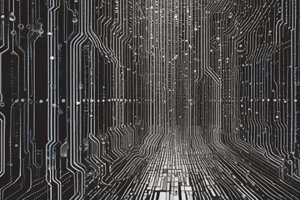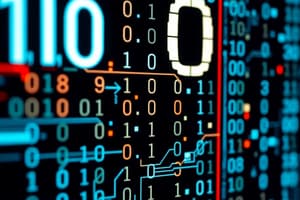Podcast
Questions and Answers
What is the base of the binary numbering system?
What is the base of the binary numbering system?
- 5
- 8
- 2 (correct)
- 10
What do the digits 0 and 1 represent in digital electronics?
What do the digits 0 and 1 represent in digital electronics?
- High and low voltage, respectively
- Off and on, respectively (correct)
- Positive and negative charge, respectively
- On and off, respectively
What is the purpose of using binary numbers in computer systems?
What is the purpose of using binary numbers in computer systems?
- To make it easier to store and manipulate data electronically (correct)
- To increase the need for memory
- To reduce the need for switches
- To make calculations more complex
What is the result of adding 1 + 1 in binary arithmetic?
What is the result of adding 1 + 1 in binary arithmetic?
What is the process of dividing a dividend by a divisor to find a quotient and possibly a remainder in binary arithmetic?
What is the process of dividing a dividend by a divisor to find a quotient and possibly a remainder in binary arithmetic?
How do you perform multiplication in binary arithmetic?
How do you perform multiplication in binary arithmetic?
What is the significance of the position values in binary numbers?
What is the significance of the position values in binary numbers?
What is the purpose of using binary numbers in programming languages?
What is the purpose of using binary numbers in programming languages?
Flashcards are hidden until you start studying
Study Notes
Binary Numbering System
- Named after its base, which is 2
- Has 2 digits: 0 and 1
- Position values for a binary number are 2^x, where x is an exponent, and each position is twice the weight of the preceding one
Importance in Digital Electronics and Computing
- Used extensively in digital electronics and computing due to ease of representation using switches (0 = "off", 1 = "on")
- Allows for electronic storage and manipulation of data using digital circuits
Representation and Manipulation
- Used for representing and manipulating large binary numbers or expressing memory addresses in a compact format
- Computer programs and programming languages use number system concepts to perform arithmetic operations, store data, and communicate with hardware devices
Binary Arithmetic Operations
- Addition
- 0 + 0 = 0
- 0 + 1 = 1
- 1 + 0 = 1
- 1 + 1 = 10 (write 0, carry 1 to the next higher bit)
- Subtraction
- 0 - 0 = 0
- 1 - 0 = 1
- 1 - 1 = 0
- 0 - 1 = 1 with borrow from the next higher bit
- Multiplication
- 0 * 0 = 0
- 0 * 1 = 0
- 1 * 0 = 0
- 1 * 1 = 1
- Multiply each digit of the second number by each digit of the first, then sum the results
- Division
- Divide a dividend by a divisor to find a quotient and possibly a remainder
- Subtract in binary, bringing down the next digit
Studying That Suits You
Use AI to generate personalized quizzes and flashcards to suit your learning preferences.




